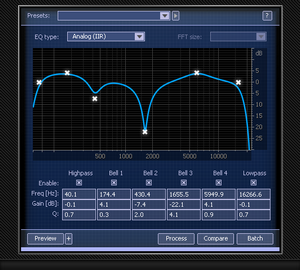Analog mastering and digital mastering
Introduction
Maybe 90% of the modern mastering studios are equipped with both analog and digital gear. These studios can offer to their clients both the solutions, included the hybrid solution in which analog and digital gear are used together.The remaining 10% of the studios comprehend few analog "purist", which use only analog gear, and a certain number of small "all digital" mastering studios, which use only digital equipment, mainly "in the box": these are audio plugins placed directly in the Digital Audio Workstation (DAW).
Today, almost all the mastering engineers think that the modern digital plugins have reached a very high quality level, and that it is possible to master with a 100% digital chain with very good results. However, the possibility to use real analog gear and to combine the analog color with the digital precision and cleanliness, is an advantage that clients tend to appreciate very much.
It's difficult to describe with words which can be the difference between an analog and a digital master, so it's definitely better to listen to a practical test...
Description of the audio test
We hear often about analog and digital mastering. Some people appreciate one approach more than the other one, but which are the real differences? Overall, counter posing these two approaches has yet a meaning, or a hybrid approach is the best one (as many mastering engineers think)?I have done here an audio test, mastering the same track in two different ways: with a 100% digital chain and with a 100% analog one. The track is named “Il volo di Nino”, by the italian band Musitheà, from the self-released EP “Accento Divino”. In both the versions, the track has been mastered at a quiet high loudness level, with peaks around -7 LUFS. The mastering philosophy has been the standard one for me: obtaining a full bodied, warm, balanced and natural sound. In both the versions the mastering chain has been very simple.
In the 100% digital mastering version the chain has been the following:
- Digital mono band compressor
- Digital equalizer
- Digital brickwall limiter
- DA conversion
- Analog solid state compressor
- Analog solid state equalizer
- AD clipping and conversion
- 0.3 db reduction in the digital domain
Original mix:
100% Analog master:
100% Digital master:
Observations and conclusions
Which are the differences?- Under the tonal point of view, the analog version has a more aggressive sound. Mid frequencies are more powerful, while high frequencies are softer. Bass frequencies are slightly deeper in the digital master. This is probably caused by the use of a high pass filter in the digital version; in the analog one, sub frequencies have been cut with a bell
- Regarding the macro dynamics, the digital master is more compressed and dense. This because the brickwall limiter has compressed some macro dynamics too, along with the peaks. On the other hand, in the analog master, the AD clipping has contributed only to peaks compression, without compressing the macro dynamics too
- Regarding the micro dynamics, in the analog track transients have more impact, and this is evident overall on the snare and the kick. This effect is due mainly because of the use of clipping instead of the limiter. Clipping the AD converter for maximizing the loudness level allows to retain most of the transients impact, but brings more distortion, compared to brickwall limiting. For this reason, the analog track has more impact on the transients but also a little distortion. The digital track has less impact but is cleaner
- In the digital version, the stronger compression of the transients brings all the instruments “in the face”, closer to the listener. On the other hand, in the analog version the snare and the kick appear to be closer, while the other instruments are a little behind
- The stereo field is a little narrower in the analog master. This is probably due to the brickwall limiter used in the digital version, which has the collateral effect to reduce the relative output level of the mid channel, thus increasing the side channel relative level
- Regarding the distortion level, as said before, the digital version appears to be cleaner. In the analog version, a little distortion is perceivable overall on the transients. However, this distortion is coherent with the track genre
I am convinced that today (2016) a good master can be obtained with both analog and digital gear, or with an hybrid approach. The most important thing is being able to choose the right tools with the right settings. This can be achieved only with years of experience, specifically in the mastering process, and a very good monitoring system.


Comments
Post a Comment